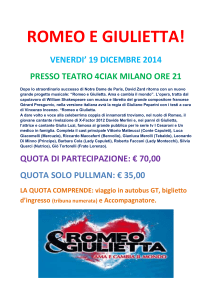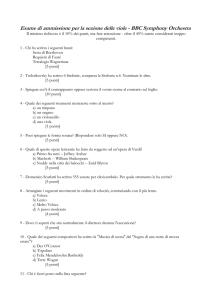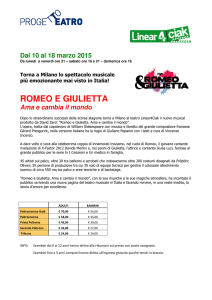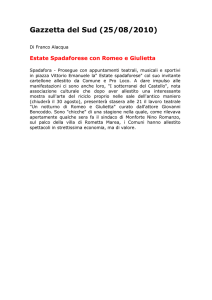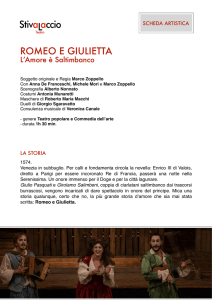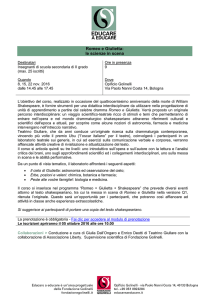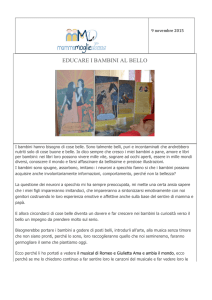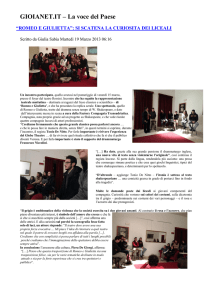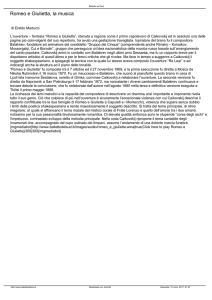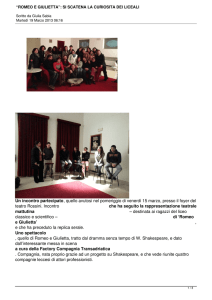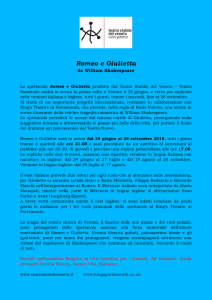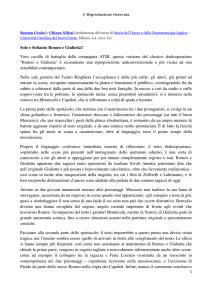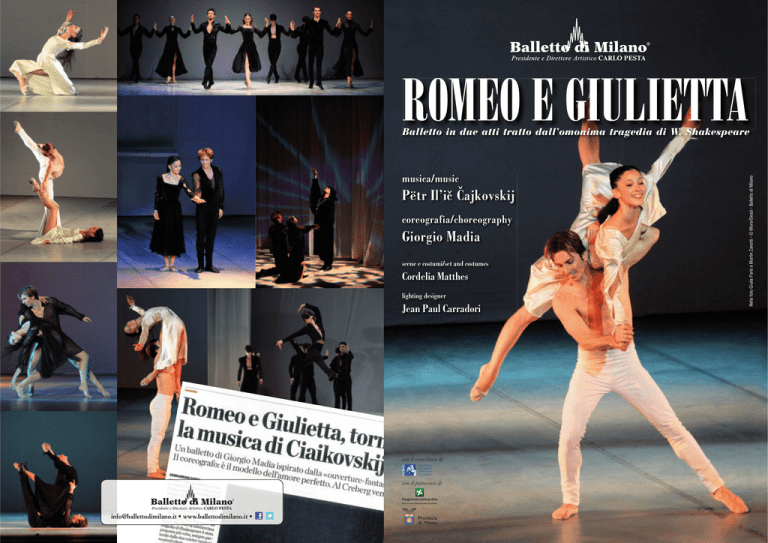
®
ROMEO E GIULIETTA
musica/music
Pëtr Il’ič Čajkovskij
coreografia/choreography
Giorgio Madia
scene e costumi/set and costumes
Cordelia Matthes
lighting designer
Jean Paul Carradori
con il contributo di
con il patrocinio di
®
[email protected] • www.ballettodimilano.it •
Nella foto Giulia Paris e Martin Zanotti - © Moro/Dessì - Balletto di Milano
Balletto in due atti tratto dall’omonima tragedia di W. Shakespeare
Note drammaturgiche
La messa in scena di un classico pone sempre l’autore (il regista,
coreografo, sceneggiatore) nell’arduo dilemma se riproporre il
soggetto seguendo fedelmente l’originale o se reinterpretarlo.
Nel primo caso egli asseconda l’aspettativa del vasto pubblico
ma rischia l’appiattimento della mera esposizione; nel secondo
può azzardare una forma critica, offrendo la sua personale
interpretazione che rischia di deludere il pubblico interessato
ad una scontata storia originale ma non ad una opinione su di
essa. Nella creazione degli spettacoli ho sempre dato spazio
alla mia fantasia sottraendomi a formule teatrali definite.
Tuttavia in Romeo e Giulietta mi affascinava l’opera originale:
testo e rappresentazione scenica. Ho cercato quindi una terza
via. Il linguaggio della danza, come diceva Béjart, non deve
esprimere concetti molto complicati ma solo i più semplici:
vita, morte, guerra, amore, tristezza e gioia. Il dramma di
Romeo e Giulietta, come nell’immaginario collettivo, è per me
l’archetipo, l’icona, dell’amore perfetto anche se (o proprio
perché) in contrasto con la società e con il mondo. Quindi
la chiave della mia interpretazione ha richiesto, seppur nella
tradizione del testo, la ricomposizione temporale degli eventi:
una storia che parte dal culmine del dramma e si snoda con lo
scopo di enfatizzare l’icona. I contrasti di vita e morte, amore e
guerra, giorno e notte, sono evocati dai colori bianco e nero in
uno scenario che, secondo la semplicità del teatro elisabettiano
e shakespeariano, rinuncia a pesanti strutture scenografiche e
si avvale di pochi attori interpreti nei diversi ruoli. (Giorgio
Madia)
Giorgio Madia
Classe 1965, studia danza presso la prestigiosa scuola di ballo
del Teatro alla Scala, diplomandosi nel 1984. Nel 1983 entra
a far parte del corpo di ballo della Scala e dal 1985 è ballerino solista per diverse compagnie di balletto. È stato Maître de
Ballet, assistente coreografo e coreografo per il Balletto di Toscana, il balletto della Komische Oper di Berlino, del Teatro di
Basilea e del Grand Teatr Łodz. Dal 2003 al 2005 ha ricoperto
la carica di direttore del balletto della Volksoper di Vienna. Ha
creato numerosissime coreografie di successo per il Balletto di
Milano, il Teatro dell’Opera di Cottbus, il Festival di Danza di
Lodtz e il Teatro di Lodtz, il Teatro dell’Opera di Vienna, il Teatro dell’Opera di Berlino, il Teatro dell’Opera di Breslavia. È
inoltre docente in Spagna anche in Austria, Germania e Israele
e all’Università Konservatorium di Vienna. Ha inoltre vinto i
seguenti premi: nel 2006 il Gold Mask Critics Award per la miglior produzione con La Bella Addormentata, nel 2007 il Gold
Mask Critics Award per la migliore direzione con Cinderella,
nel 2008 il Gold Mask Critics Award per la migliore direzione
con Les Contes d’Hoffmann, il Premio “Danza in Fiera l’Italia
che danza 2010” come miglior coreografo e il Premio Anita
Bucchi 2011 per la sua Cenerentola.
Notes on the performance
Romeo e Giulietta: la storia
Romeo and Juliet: synopsis
While staging a classic, the author (a director, a choreographer, a
scriptwriter) always faces a difficult dilemma whether to develop
the plot exactly as it is given in the source or to reinterpret it.
In the first case, they go along with the audience’s expectations
but risk depriving their performance of some appeal. In the
second case, they can hazard a critical form and offer their
personal interpretation which might disappoint the audience
disposed rather to get an expected original story than another
view of it. Creating performances I have always given some
latitude to my imagination and tried to avoid known dramatic
formulas. However, in Romeo and Juliet I was carried away
with the original story, both its text and the scenery. I searched
for a third solution, therefore. As Béjart said, the language of
dance should not express complex concepts but basic ones: life,
death, war, love, grief and joy. The Romeo and Juliet drama,
both in the collective imagination and for me personally, is an
archetype, an icon of a perfect love although (or just because)
it is in conflict with the society and the world. Thus, my
interpretation of the drama required a temporal rearrangement
of the events (though they follow the traditional plot): the story
starts with the culmination of the drama and then unfolds
to emphasize the icon. The contrasts between life and death,
love and war, day and night evoke in black and white scenery.
True to the simplicity of the Elizabethan and Shakespearian
theatre traditions, the latter tends to abandon heavy scenery
structures and avail itself of a few actors engaged in different
parts. (Giorgio Madia).
La tragedia Romeo e Giulietta di William Shakespeare racconta
le vicende di due nobili famiglie di Verona: i Montecchi e i
Capuleti, acerrime nemiche, che spesso si combattono.
The tragedy Romeo and Juliet by William Shakespeare tells the
story of two noble families of Verona: the Montagues and the
Capulets, sworn enemies who often fight battles with each other.
Parte prima. Il Dramma. Romeo appresa la notizia della morte
di Giulietta, si precipita a Verona e si reca al sepolcro per
vedere l’amata un’ultima volta. Qui incontra Paride e tra i due
ha luogo un duello. Romeo ha la meglio e poi, dopo aver dato
l’ultimo bacio a Giulietta si toglie la vita bevendo del veleno.
Giulietta si risveglia, ma accanto a lei giace Romeo ormai morto
ed ella si pugnala con la spada del suo amante per morire al
suo fianco. A tutti non resta che piangere sui corpi dei due
sfortunati giovani.
First part. The plot: Romeo learns about Juliet’s death and
hurries to Verona where he goes to the crypt to see his beloved
for the last time. He encounters Paris, and after confronting each
other in a battle, Romeo fatally wounds Paris. Then he gives his
last kiss to Juliet and drinks the poison to kill himself. Juliet then
awakens and, seeing dead Romeo, stabs herself with her lover’s
sword to die by his side. There is nothing else left to do but to
mourn for two young lovers.
Born in 1965, he studied dance at the
prestigious ballet school of Teatro alla
Scala, graduating in 1984. In 1983 he
joined the corps de ballet of La Scala
since 1985 and then he was solo dancer
for various companies. He was ballet
master, choreographer and assistant choreographer for the Balletto di Toscana,
the ballet of the Komische Oper Berlin,
the Basel Theatre and the Grand Theatre in Lodz. From 2003 to
2005 he held the position of Director of the Ballet of the Vienna
Volksoper. He created successful works for Balletto di Milano,
Staatsoper Cottbus, Lodtz’s Festival and Opera, Wiener Staatsoper, Staatsoper Berlin, Wroklaw Theatre. He is also teacher in
Spain, Austria, Germany, Israel and at the Wiener Konservatorium at the University. He also received the following awards:
in 2006 the Gold Mask Critics Award for Best production of
Sleeping Beauty, in 2007 the Gold Mask Critics Award for best
direction with Cinderella, in 2008 the Gold Mask Critics Award
for best direction in Les Contes d’Hoffmann, “Prize Danza in
Fiera 2010” as best choreographer and “Prize Anita Bucchi 2011”
for Cinderella.
Romeo Montecchi, che crede di essere innamorato della
bella Rosalina, decide di introdursi mascherato con gli amici
Mercuzio e Benvolio ad un ballo disposto dal capo dei
Capuleti per permettere alla figlia Giulietta di incontrare
il giovane nobile e ricco Paride. Questi ha infatti chiesto la
mano di Giulietta e i genitori di quest’ultima sono favorevoli
all’unione. Alla festa, però, Romeo resta folgorato alla vista di
Giulietta. Lo stesso è per lei, ed entrambi si rendono conto
di essersi innamorati ciascuno del proprio peggior nemico. Al
termine della festa Romeo si reca da Giulietta e i due giovani,
pur consapevoli della rivalità tra le loro famiglie, si giurano
amore eterno.
Romeo Montague believes to be in love with a beautiful girl
named Rosaline. With his friends Benvolio and Mercutio, he
decides to sneak secretly into the ball planned by Capulet in
order to let his daughter Juliet meet a young and rich nobleman
Paris. The latter had already asked for Juliet’s hand and her
parents were in favour of the marriage. However, at the ball
Romeo becomes infatuated with Juliet realizing that she is his
true love. Juliet feels the same but two young people desperately
discover that each of them got in love with the enemy. After the
ball, Romeo hides under Juliet’s balcony and confesses his love to
her. He is overjoyed when he hears Juliet returning her affection
to him. The young people vow their eternal love to each other in
spite of their families’ hatred.
Parte seconda. Il giorno seguente Romeo non fa che pensare
a Giulietta, sognando il giorno in cui la sposerà. Arriva la
nutrice di Giulietta gli consegna una lettera dell’amata nella
quale lei acconsente a sposarsi segretamente grazie all’aiuto
di Frate Lorenzo. Il destino vuole che proprio quel giorno
Romeo incontri Tebaldo, cugino di Giulietta, che, furioso
per aver scoperto l’intrusione alla festa, lo sfida a duellare.
Romeo però rifiuta di battersi e il suo giovane e brillante
amico Mercuzio, indignato da questo comportamento,
prende il suo posto per battersi contro Tebaldo. Purtroppo
viene ucciso da quest’ultimo e alla vista del caro amico morto
Romeo uccide Tebaldo.
Il giorno successivo, dopo aver trascorso la notte con l’amata
Giulietta, Romeo ormai ricercato fugge in esilio a Mantova.
Il padre di Giulietta nel frattempo forza la figlia alle nozze
con Paride e lei su consiglio di Frate Lorenzo finge di
acconsentire. Il buon frate le fornisce un filtro che la farà
apparire morta per quaranta ore, così egli avrà il tempo di
informare Romeo. Il destino si accanisce nuovamente contro
due giovani perché Frate Lorenzo non arriverà in tempo
da Romeo. Giulietta dunque beve la pozione e si compie il
dramma.
Second part. The next day Romeo can not help thinking about
Juliet and dreams that day when they will join each other. Juliet’s
nurse takes the trouble to bring him a letter from his beloved
that agrees to marry him. Friar Laurence, who was Juliet’s
confessor and Romeo’s confidant, joins them in marriage secretly
from the families. However, it was destined to happen that later
that day Romeo meets Juliet’s cousin Tybald who is incensed
by Romeo’s having sneaked to the ball and challenges him to
a duel. The latter refuses to fight, and his young and vigorous
friend Mercutio fights Tybalt on Romeo’s behalf. Romeo tries
to break up the fight between two rivals but Tybalt wounds
Mercutio to death. Furious, Romeo confronts and kills Tybald.
Now, after having spent the night with his beloved Juliet, Romeo
is prosecuted and has to flee. He leaves Verona for Mantua urged
by Friar Laurence who promises to announce the marriage at
an opportune time. Meanwhile, Juliet’s father insists that his
daughter should become Paris’s wife. She pretends to agree on
Friar Laurence’s advice who has elaborated a plan: Juliet should
take a drug that will make her seem death-like for forty-two
hours. Then, the Friar will inform Romeo to come and take her
to Mantuaas soon as she awakens. Juliet drinks the drug and the
tragedy occurs.
Epilogo. I due giovani si incontrano e la vicenda è ripercorsa,
ma essi sono finalmente liberi, di fuggire, di amarsi in un’altra
dimensione dove odio e rancore non trovano spazio. Una
speranza, un augurio…
Epilogue. The two young lovers meet each other and the story
returns. They are finally free to run away and love each other
in another dimension where there is no space for hatred and
resentment. A hope, a good wish …
La Musica del Balletto
(Nelle foto il Balletto di Cracovia)
Prima parte Romeo & Giulietta1880 (esclusa la coda finale);
Fanciulla di neve, Entr’acte (Nr. 5b, atto I); Amleto, Entr’acte
(Nr. 7, atto III); Entr’acte (Nr. 5, atto II); Fanfara (Nr. 15);
Fanciulla, Danza dei buffoni (Nr. 13, atto III); Fanciulla,
Entr’acte, frammento (Nr. 8, atto II); Danza (ripresa); Amleto,
Mélodrame (Nr. 4, atto I); Terza Sinfonia, Andante.
Seconda parte R&G1869, Introduzione; Suite Nr. 1, Marche
miniature; R&G1869: dall’inizio dello sviluppo alla fine;
Amleto, Mélodrame (Nr. 8, atto III); Entr’acte (Nr.9, atto
IV); Suite Nr. 1, Marche miniature (ripresa); Intermezzo;
R&G1870, parte finale.

